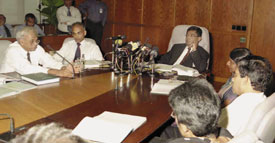|
DAILY NEWS ONLINE |
|
|
|
OTHER EDITIONS |
|
|
|
|
|
|
|
|
|
OTHER LINKS |
|
|
|
|
|
|
 |
|
Annual Report 2004 released: High growth reflects economic resilience - Central BankThe economic growth rate of 5.4 per cent in 2004 was largely supported by the strong performance in exports, consumption and investment and the resurgence of economic activities, the Central Bank said yesterday.
Presenting the Central Bank Annual Report 2004 yesterday, Central Bank Governor Sunil Mendis and senior officials said the growth rate reflected the economy's resilience to the many adverse shocks the country had to face during the year - the surge in international oil prices, a severe drought in the early part and the floods later and the tsunami disaster. "Sri Lanka's per capita GDP exceeded US dollars 1,000 for the first time. With this achievement, the country is on its way to becoming an upper middle income country," said the Bank's Director of Economic Research Dr. H.N. Thenuwara. "The government that took office after the April General Election in April, set new directions to the growth and poverty alleviation programmes with a greater focus on a regionally balanced growth as well as rural and small and medium sector development," the Report said. Governor Mendis and Thenuwara said Sri Lanka should achieve at least 6 to 8 per cent growth to meet targets of poverty alleviation and economic prosperity. "The government's policy statement and the medium term macroeconomic framework announced with the Budget 2005 set out broad strategies to achieve macroeconomic stability and a regionally balanced economic growth rate of 6-8 per cent over the medium-term," the report added. "The growth is expected to accelerate to over six per cent from 2006 onwards spreading across all sectors and geographic regions with the renewed emphasis on regional development as well as the nation rebuilding programme by the Government." A significant development in 2004 was the contribution made by the services sector to economic growth. The Services sector, which grew by 7.6 per cent in 2004, contributed 77 per cent to the overall growth. Strong external and domestic demand helped the Industry sector to grow by 5.2 per cent, contributing 25.7 per cent to the overall growth. The Agriculture sector recorded a negative growth of 0.7 per cent in 2004 due to several factors including the drought and floods. "The key to raising agricultural productivity lies in the introduction of high yielding varieties, the use of new technology such as drip irrigation and poly tunnels, the adoption of research and technological developments, the use of advanced crop practices through international partnerships and the more efficient use of inputs," the Report states. Investments improved in 2004, with the investment/GDP ratio improving to 25 per cent from 22.1 per cent in 2003, entirely due to increased private investment. The Report noted that inflation began to rise in 2004 with the drought and the higher fuel prices leading to high cost-push inflation, while the increase in money supply and fiscal expansion, led to demand-pull inflation. Monetary policy during 2004 aimed at containing inflationary pressures, while supporting economic growth, the Bank said. "A high import growth of 20 per cent, largely due to high international fuel prices, surpassed the 12 per cent growth in exports and the 11 per cent increase in worker remittances," the Report added. International oil prices increased sharply in 2004, raising Sri Lanka's average import price of crude oil to US dollars 37 per barrel from US dollars 29 per barrel in 2003, resulting in an increase in the oil bill by US dollars 372 million. "That could have been used for investment - for example, meeting the cost of a large investment project such as the Southern Expressway," Thenuwara told the media. "The fiscal consolidation process continued in 2004 with the government introducing a series of measures to improve the revenue performance and rationalise expenditure. These included the strengthening of the tax administration, the introduction of the Economic Service Charge (ESC), the revision of administered prices, the rationalisation of recurrent expenditure, the strengthening of public enterprises by setting up the Strategic Enterprises Management Agency (SEMA), and the establishment of the Administrative Reforms Committee (ARC) and the National Council for Administration (NCA). The Report predicted that economic growth would suffer in 2005 albeit marginally, mainly due to the impact of the tsunami on the fisheries and tourism sectors. Increased rebuilding activities would compensate to some extent for the loss of economic activities in fisheries and tourism. The Bank warned that several downside risks remain in achieving the immediate as well as the medium term targets. First, the risk of a further escalation of international oil prices still remains. Any further increase in oil prices could exert a heavy burden on the economy and the people. "Second, the global economy has already shown signs of a slowing down in 2005. This may threaten Sri Lanka's export performance. Third, Sri Lanka's major export industry, the textile and garments, is faced with increased competition in the world market due to the phasing out of the Multi Fibre Arrangement (MFA) in 2005. Fourth, any delay in the disbursement of pledged foreign assistance may delay the urgent rehabilitation and reconstruction work, affecting the overall economic performance." |
|
|
|
 |
 |
 |
 |

